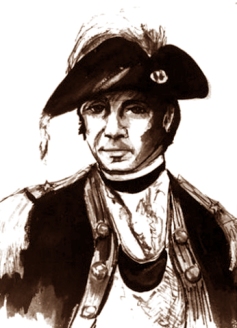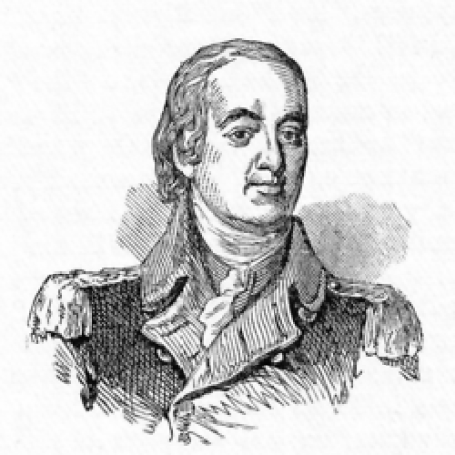On the morning of August 22, 1776, the British frigates Phoenix, Rose, and Greyhound with their sails spread open in the hot sun weighed anchor off Staten Island in New York harbor and fell down The Narrows accompanied by two bomb ketches, the Carcass and the Thunder. British Generals Henry Clinton and Charles Cornwallis with an advance corps of 4,000 of the King’s elite troops pushed off in flatboats and proceeded across the three miles of water to the long beach at Gravesend Bay on the southwest tip of Long Island. The warships pointed their cannon at the beach. By eight in the morning, the whole coast swarmed with boats. Then, a signal gun fired from British Admiral Richard Howe’s flagship, the Eagle.
The English and Scottish artillerists disembarked first. A battalion of Hessian grenadiers with muskets in hand disembarked in order of battle ranks. The Scottish dressed in kilts and wielding muskets, pistols, bayonets, and broadswords arrived. More troops followed, including women and children whose husbands and fathers were with the army. By noon, a fully equipped army of 15,000 men and forty pieces of artillery had landed and assembled in formation.

At Kennedy House in Manhattan, General George Washington initially received erroneous information about the number of the enemy force. He was told there were 6,000. Washington was already anxious because his commander of the American forts on Brooklyn Heights, Major General Nathanael Greene, was critically ill and at a doctor’s house in Manhattan. General John Sullivan was assigned to take Greene’s place. In response, on August 25, he sent General Israel Putnam across the East River with six brigades to the American fortifications on Brooklyn Heights. Putnam was to assume command from General John Sullivan and reassign him to the center at Flatbush Road with 1,000 troops. General Alexander Stirling was responsible for the Gowanus Road on the right with the elite First Maryland Regiment, a Pennsylvania battalion, and Delaware regiments. Colonel Samuel Miles was to provide protection for the left flank of the Continental Army at Bedford Road with 800 men.
They had failed to cover a fourth pass known as the Jamaica Pass, that lay three miles north of the American left flank on the Bedford Road. It was a blind spot in the American defenses patrolled by only five young militiamen. The Continental Army had no cavalry and no spies, and the troops were unfamiliar of the lay of the land on Long Island. A force of fewer than 3,000 inexperienced American soldiers was expected to hold a ridge four miles long, while the rest, another 6,000 remained within the Brooklyn Heights forts: Greene, Putnam, Box, and Cobble Hill. The white tents of the British army, spread across the Flatlands, could be seen from the heights near Gowanus Road. The sight was alarming enough to cause some of the Americans to desert.

From his headquarters in the British encampment, General William Howe laid out plans to distract the rebels and keep them stationary while the main body of the British forces executed a sweeping flanking maneuver through Jamaica Pass. Howe assigned General James Grant two brigades which would cause a diversion close to The Narrows on the enemy’s right on the coast of the Upper Bay. Hessian General Leopold von Heister’s 4,000 Hessians would occupy the Americans’ center. General Charles Cornwallis was to back up Grant on the enemy’s right with grenadiers and the Scottish. General Henry Clinton was to command the advanced guard while Howe followed with the rest of the main force of 10,000 men.
On August 26 at 9:00 p.m, the British generals moved out to their assigned positions. No one except the commanders knew of the plan. General James Grant led 5,000 redcoats toward the Red Lyon Inn on the coast of the Upper Bay near Gowanus Road where Pennsylvania riflemen were patrolling. The riflemen were relieved around two o’clock in the morning by green militiamen. Grant sent 300 men to attack the terrified men, who fled.
General Israel Putnam was alerted to this British movement. Alarm guns sounded and drums rolled as the men in the forts fell out in response to the alarm. Putnam believed it was the frontal assault and rushed to alert General Alexander Stirling whose troops were at Gowanus Road.
The men under Stirling’s overall command marched toward the enemy. A little before day light, they saw Grant’s regiments advancing along Gowanus Road with colors flying and field artillery out front. Before they could form lines, Grant’s artillery fired on Stirling’s vanguard in a thunderous profusion of smoke and shot. Stirling shouted for his men to deploy. “Stretch out and form a V so we may have a chance to face these rascals in their own formations!”
The rebels volleyed and then fired on the British with two cannons. Grant pulled his troops back and switched to a steady artillery barrage.

Major Mordecai Gist, who was in command of the Marylanders, moved them to the right flank on top of a hill. The Marylanders successfully withstood the British cannonade which was what Grant hoped. His diversion was working. The Marylanders, believing that they were engaged with the enemy’s main assault, valiantly stood their ground without realizing that Grant sent a detachment eastward to link up with the Hessians and General von Heister in the center to surround them.
Colonel John Chester, of Connecticut, was entrenched with the Continentals at Bedford Pass with his adjutant Lieutenant Benjamin Tallmadge. Chester’s men could not maintain their ground at the pass and were forced to retreat to Brooklyn Heights.
William Howe and Henry Clinton’s flanking maneuver was unfolding as planned. They moved their 10,000 troops from the camp at Flatbush and advanced toward Jamaica Pass along the Jamaica Road. At 9:00 a.m., Howe fired two cannons, announcing his arrival in the village of Bedford north of Jamaica Pass.
General von Heister and three Hessian brigades, that formed a line nearly a mile long, approached the center of the American lines where General John Sullivan’s troops were positioned. Sullivan’s troops panicked when they saw the Hessians with colors flying and drums beating. Without firing a shot, the Hessians pressed forward until they could employ their bayonets. They broke through Sullivan’s line on the right and ruthlessly butchered the rebels.
Sullivan struggled to keep his men from panicking. He called for a retreat and led them from the center at Flatbush Pass in the direction of the Brooklyn Heights fortifications. The Hessians kept up their bayonet assault. Hundreds of rebel troops raced through the woods and fields to reach the forts. A detachment of British General Charles Cornwallis’ grenadiers chased them right up to the walls. Sullivan and some of his troops were taken prisoner.
Less than a mile west of Sullivan’s position and with the enemy converging on all sides, Gist and five companies of Marylanders pushed through their original bivouac area. Flanking fire pelted them from both sides until they came to a marsh and a stone farmhouse where Cornwallis’ forces were positioned at the Vechte farm.
To buy time for his troops to escape, Stirling took the Marylanders on a suicidal preemptive strike against Cornwallis’ position in and around the farmhouse and the orchards. Cornwallis’ men aimed their muskets and light cannon on the advancing Marylanders. The fusillade dropped many of the men in their tracks, severing limbs and heads, killing several instantly. The Marylanders formed into lines and charged into the hail of fire coming from the British soldiers in the Vechte house.

The Hessians attacked the Marylanders. They linked up with Cornwallis’s Scottish Highlanders and assaulted the Marylanders from the rear, while Grant’s forces pushed in the front. Major Mordecai Gist noticed a fateful pause. The Marylanders realized to their horror that they were flanked. They heard fire on their left, and in a short time discovered part of the enemy in their rear. Surrounded on all sides by at least 10,000 men, the Americans were driven with precipitation and confusion. Maryland’s finest lay dead and dying all around.
General Alexander Stirling found himself surrounded with no hope for escape. He surrendered his sword to the Hessian general von Heister. The Hessians and Highlanders gave no quarter and dispatched the rebels with their bayonets, pinning some to trees, after they had surrounded them. The Maryland officers were the first to be killed or captured. Sixty men were taken prisoner. The rebels were cut off from the retreat by Cornwallis, and Gowanus Creek remained the only avenue of escape for any not crushed between the British and Hessian forces.
The waters of the bay were at high tide, making Gowanus Creek and the adjoining marshes nearly impassable. The men had to wade and swim through waist-and often neck-deep water, while trying to evade the British fire. Many suffocated in the mud or drown.
The Delaware regiment scattered. They were unable to defend themselves against the ruthless men pursing them. They fled through the woods carrying their torn regimental colors.

General Samuel Parsons’ men, who had been holding the hill on Stirling’s left flank before he retreated, turned to see that the line they were defending was gone. With Grant pressing them, they too tried to escape but found Cornwallis blocking the road. Unable to get to the creek, Parsons’ men dispersed into the woods under pursuit and most were killed.
All night, after the guns grew silent, the Americans inside the Brooklyn defenses, expecting the British to attack, waited tensely hour after hour as nothing happened. Stragglers who had escaped capture kept coming into the lines, bedraggled single soldiers, many badly wounded. The morning after, Mordecai Gist and nine others Marylanders returned to the fortifications. They were the only ones of the valiant Marylanders to have made it back.
General William Howe’s army had crushed Washington’s forward defense, but Howe ordered his men to halt instead of storming the American fortifications on Brooklyn Heights.
George Washington and his staff left Kennedy House in Manhattan for Brooklyn Heights after receiving a message that General John Sullivan and General Alexander Stirling were taken prisoner. General Thomas Mifflin’s brigade of Pennsylvanians, and two regiments of mariners from Marblehead, Salem, and Danvers, Massachusetts under the command of Colonels John Glover and Israel Hutchinson arrived.
Then, a storm blew in from the northeast, preventing the British ships from sailing into the East River from the harbor.
On the evening of August 28, General Howe’s engineers began digging a system of trenches called approach by advances that would shield the army as it approached and besieged the American position. They worked all night with picks and shovels, and by the morning of August 29, the British had dug a 300-yard trench parallel to the American lines and a mere 600 yards away. At the rate they were digging, the British would have been within musket shot of the rebels in less than twenty-four hours, and it would have been nearly impossible to dislodge them from their advancing trench.
Joseph Reed and Thomas Mifflin convinced Washington to make a full scale retreat from Long Island. Mifflin requisitioned every boat fit for transporting troops. With the mariners manning the boats and under cover of fog, the Americans evacuated 9,500 soldiers in a single night with all of their baggage, tents, equipment, and horses.
Resources:
O’Donnell, Patrick K. Washington’s Immortals New York: Grove Press, 2016. Print.
Schecter, Barnet. The Battle For New York New York: Walker & Company, 2002. Print.
McCullough, David. 1776 New York: Simon & Schuster, 2005. Print.









